LOWER BEAK
We examined beaks of Mp. hjorti from three individuals (43, 97, 115 mm ML). The smaller specimen was from the tropical Pacific and is excluded from the list of characters. The following characters are taken from Clarke (1986). Means from the large two specimens are used for measurements.
- Pigmentation - Darker than most mastigoteuthids.
- Pigmentation pattern - Beak nearly fully pigmented at 115 mm ML, slight unpigmented region at the tip of the shoulder padding and unpigmented anterior margin of shoulder/wing. The pigment of the wing forms a narrow connection (a wrist) to the hood pigmentation.
- (Wing length)/(visible rostral edge) (profile) - 1.90
- Height/baseline (profile) - 1.05
- (Length from rostral tip to wing tip projected on baseline)/baseline (profile) - 0.23
- (Hood length)/(crest length) (profile) - 0.61
- (Crest length)/baseline (profile) - 0.62
- (Rostral base)/(visible rostral edge) (profile) - 1.03
- (Hood length)/(visible rostral edge) (profile) - 0.88
- Rostral width ratio [LRL/(length between jaw angles)] - 2.16
- Wing angle (= visible jaw angle in profile) - Obtuse.
- Shape of jaw edge (profile) - Proximallly nearly straight with distal poorly defined hook with straight to convex shape.
- Rostrum (Profile) - Broad taper to tip.
- Hood distance from crest - Normal to close.
- Crest - Straight.
- Lateral wall notch - Normal.
- Hood-wing - Broad.
- Hood notch - Broad to narrow.
- Lateral walls to free corner - Well separated with increasing but low divergence from one another.
- Hood midline - Slightly curved.
- Hood surface without prominent longitudinal ridges or grooves.
- Wing fold - Wing fold low, rounded; no groove between wing fold and shoulder blade; wing fold obscures jaw angle in profile.
- Shoulder blade- Shoulder blades very large, oral edges project from shoulder with more distal (relative to jaw angle) end projecting more than proximal end.
- Shoulder cartilage - Shoulder cartilage prominant at 115 mm ML.
- Jaw angle - Approximate right angle.
- Jaw edge extension without step and with prominent angle point extending well past shoulder padding; jaw edge extension without clear strip between it and shoulder blade.
- Jaw edge in cross-section - Blunt.
- Crest in cross-section - Narrow.
- Lateral wall - Distinct lateral-wall fold capped by solid ridge that doesn't overhangs base, ridge greatly diminished posteriorly; lateral wall fold with sharp medial groove and broadly sloping sides.

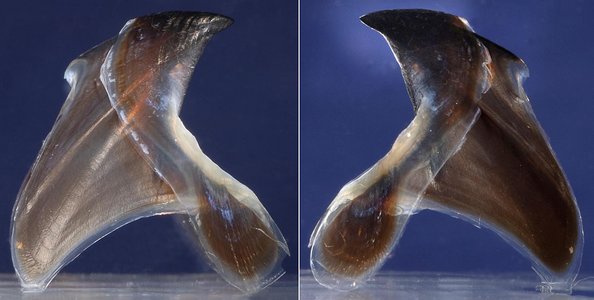
Figure. Left and right side views of the same lower beak of Mp. hjorti, 115 mm ML, 4.8 mm LRL, immature female, South Atlantic, 34°S, 17°E. Photographs by R. Young.

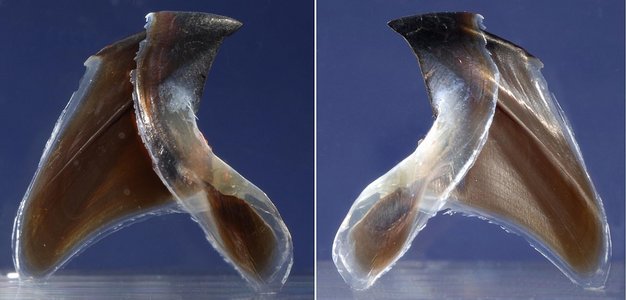
Figure. Left and right side views of the same lower beak of Mp. hjorti, 97 mm ML, 3.9 mm LRL, immature female, North Atlantic, 17°N, 23°W. Photographs by R. Young.

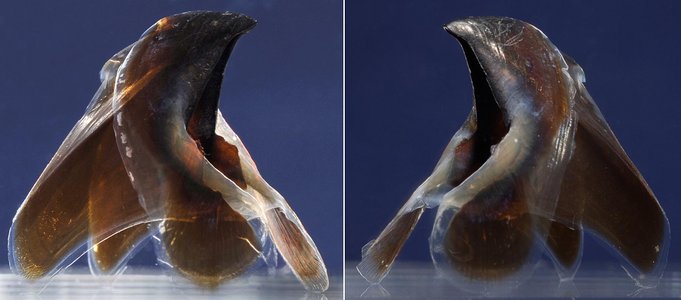
Figure. Left and right side-oblique views of the same lower beak of Mp. hjorti, 115 mm ML, immature female, South Atlantic, 34°S, 17°E. Photographs by R. Young.

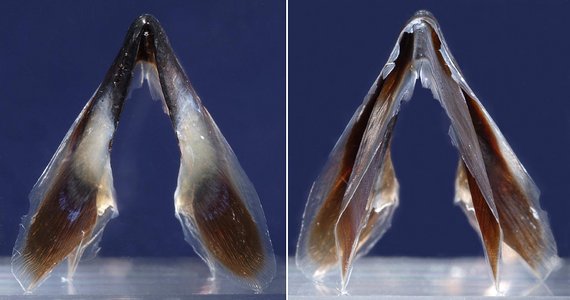
Figure. Front (left) and rear (right) views of the same lower beak of Mp. hjorti, 115 mm ML, immature female, South Atlantic, 34°S, 17°E. Photographs by R. Young.

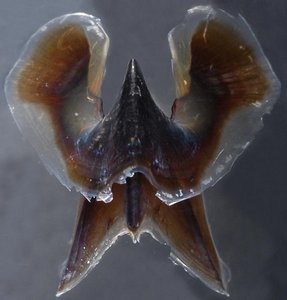
Figure. Top view of the lower beak of Mp. hjorti, 115 mm ML, immature female, South Atlantic, 34°S, 17°E. Photographs by R. Young.

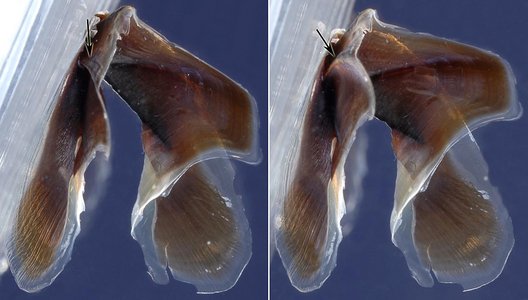
Figure. Two posterior-oblique views of the same lower beak of Mp. hjorti, 115 mm ML, immature female, South Atlantic, 34°S, 17°E, showing the width of the lateral wall ridge (arrows). Photographs by R. Young.

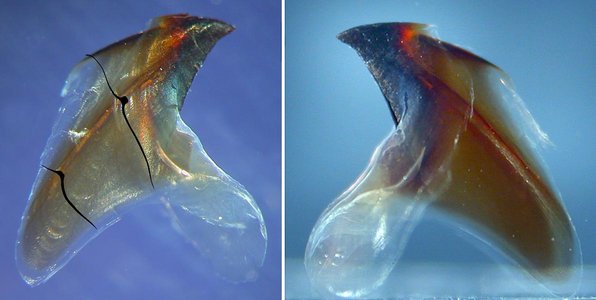
Figure. Left - Side view of the lower beak of Mp. hjorti 43 mm ML, xx mm LRL, mid-equatorial Pacific, that has been cut in half and laid flat with drawn cross-sections of the lateral wall overlayed where the cuts occurred. Right - Same beak before being cut in half. Photographs by R. Young.
Comments
The lower beak of Mastigopsis hjorti is easily separated from other members of the tall-, slender-beak species (Echinoteuthis atlantica/E. famelica and Mastigotragus pyrodes) by its broad, deep shoulder blades, more massive form, darker pigmentation and the more gradual taper of the lateral wall as it approaches the lateral-wall ridge. In addition, it differs from Echinoteuthis. atlantica/E. famelica in the rod-like rather than fin-like lateral wall ridge and from Mastigotragus pyrodes in its narrower crest and lack of an undercut lateral wall ridge. At a given body size, the beaks of Mastigopsis hjorti are far larger than other members of this group.
UPPER BEAK


Figure. Side views of the upper beaks of Mastigopsis hjorti. Left - 115 mm ML, immature female, South Atlantic, 34°S, 17°E. Right - 97 mm ML, immature female, North Atlantic, 17°N, 23°W. Photographs by R. Young.

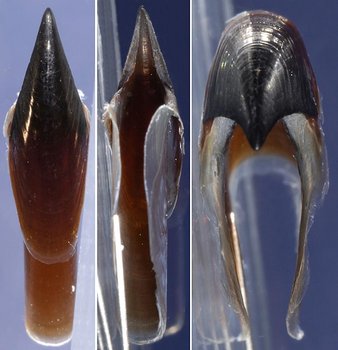
Figure. Various views of the same upper beak of Mastigopsis hjorti, 115 mm ML, immature female, South Atlantic, 34°S, 17°E. Left - Top view. Middle - Bottom view. Right - Front view. Photographs by R. Young.
Comments
To be added.




 Go to quick links
Go to quick search
Go to navigation for this section of the ToL site
Go to detailed links for the ToL site
Go to quick links
Go to quick search
Go to navigation for this section of the ToL site
Go to detailed links for the ToL site